If you haven’t seen it, you might be interested in watching our video chronicling the life cycle of the monarch– from caterpillar to chrysalis to butterfly. We also went down to the Saint Marks National Wildlife Refuge last fall for a little monarch tagging, and to learn about their Monarch Milkweed Initiative. In September 2021, we revisited the topic of monarch predators, looking at research that sheds new light on the topic.
Our second monarch-raising season started much earlier this year. At this point last year, we had just released our first six monarchs; as of Monday, we have released twenty-six (we released one on August 21, just after the eclipse).
We also have a handful of chrysalides and a few caterpillars working on what’s left of our milkweed. It’s growing back after twice having been mostly decimated, and even so, I spotted eggs earlier this week (which, since I started this draft, have hatched).
Over the last four months, we’ve had some successes and some learning experiences. The learning experiences came when we had too many caterpillars to bring in and protect. I learned last year that if you bring too many in, smaller caterpillars might get crowded out and not eat. So I’ve been trying to only bring in larger caterpillars I feel are going to soon spin their chrysalides. This means that I’ve been leaving more of them to deal with the many predators of the backyard garden ecosystem.
Now, there’s not much I can do about lizards and, as I saw with one of my black eastern swallowtail caterpillars, wasps can fly in at any time and pick them off. I do routinely brush spider webs off of my milkweed plants, and try to move spiders elsewhere.
As for the predators I can control? Some of those were kind of surprising.
Beneficial Insects Aren’t Always Beneficial- To Monarchs
The more I spend time growing milkweed and observing monarch caterpillars, the more I notice the many other insects that associate with the plant. And that’s the cool thing about observing any one plant for long enough- it’s an ecosystem unto itself.
The insects I see the most are little orange pests called milkweed, or oleander, aphids (Aphis nerii). They have no direct effect on monarchs, though they can damage milkweed by ingesting its sap and weakening the plant. Last year, they weren’t much of a problem. This year, they had been much thicker on the plants. Before I gave any thought to managing them, nature stepped in. At the time, I thought the results were kind of amazing.
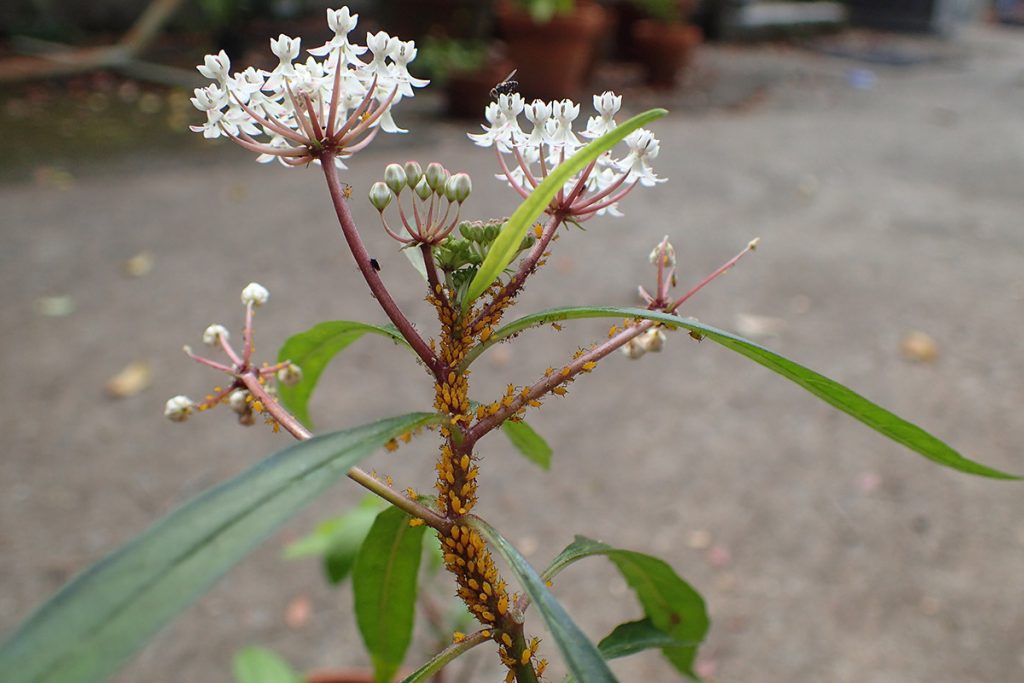
These great beneficial insect species started showing up and eating the aphids. My favorites are the syrphid larvae. The adult syrphid, or hoverfly, is a bee mimic. Last year, I saw one of its larvae on a milkweed plant and looked it up to see what it was. This year, I was pleased to see many more feasting on the throng of little orange pests.
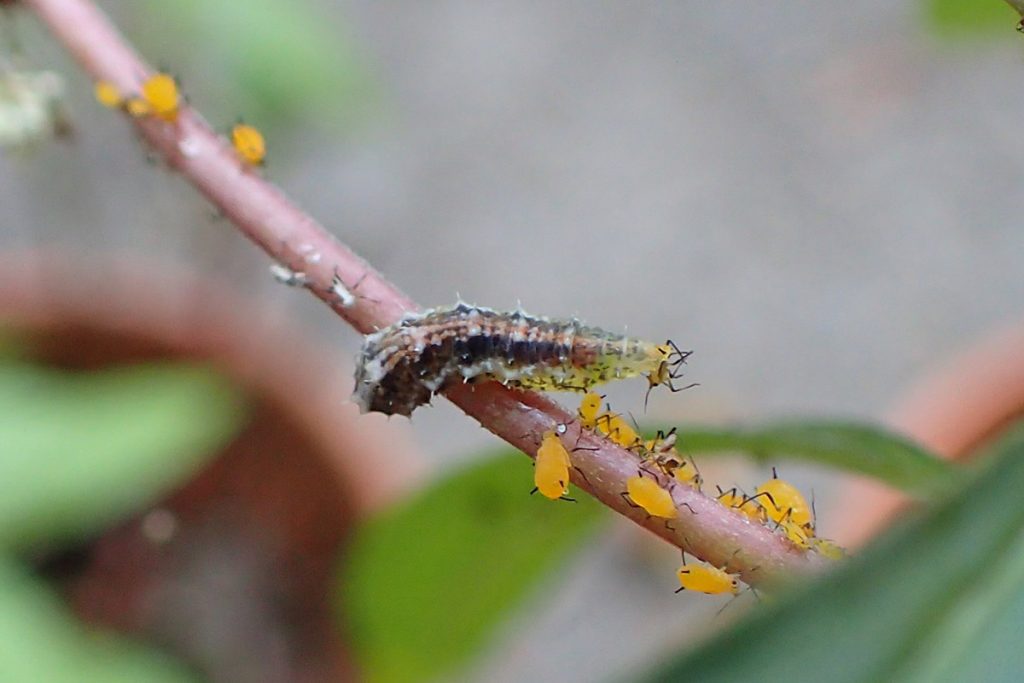
I also started seeing more ladybugs, always a welcome sight in a garden.
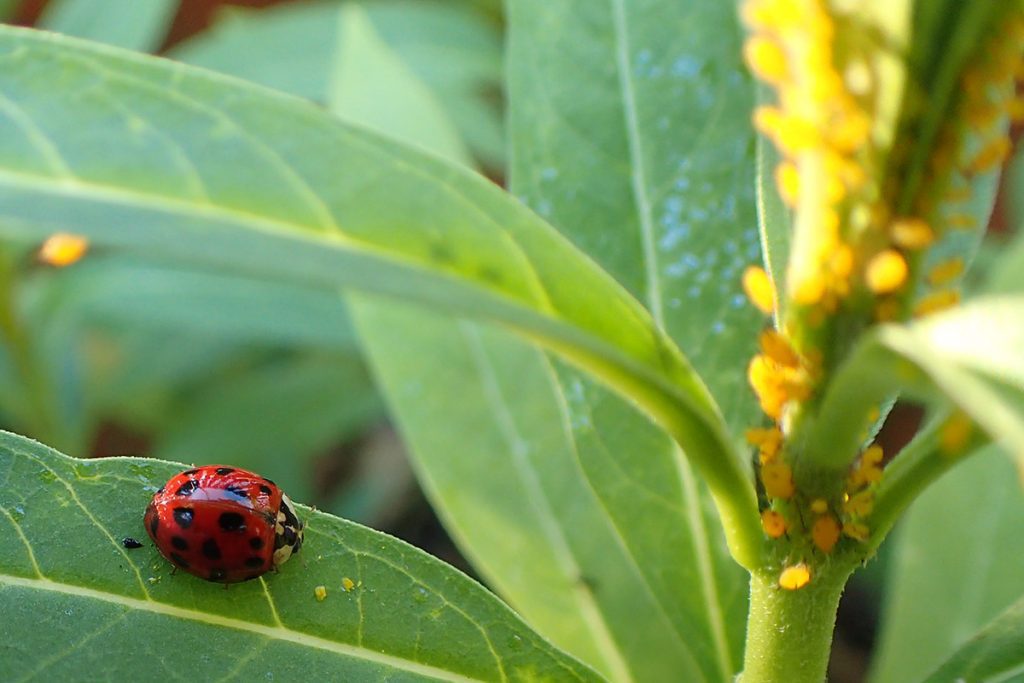
By mid-June, I was fairly pleased with our milkweed/ monarch situation. We had a dozen or two caterpillars, and the garden ecosystem was checking our pests. But then, we left town over one weekend. During the one night we were gone, many of our caterpillars vanished. We didn’t have many large caterpillars ready to make chrysalides, and there was plenty of milkweed left to eat. Something bad happened to them.
I gathered up the survivors and brought them in. Then I found one of them dead in the enclosure. Another caterpillar was sitting on the netting, with a stowaway syrphid larva sitting a few inches away. That’s when I turned to Google for some additional information.
To Milkweed, a Monarch Caterpillar is a Pest
We like insects like ladybugs because they kill garden pests. Those pests tear up our food plants and pretty flowers. But those ladybugs don’t know that we planted some of those flowers so that insects would eat them.
It was quite a surprise. Ladybugs kill monarch caterpillars. I couldn’t find anything about syrphids eating monarchs. EDIT June 2020– In the couple of years since I wrote this, I feel confident that syrphids don’t eat caterpillars. It’s not inconceivable that they could eat an early instar caterpillar, but it’s never been documented and I’ve never seen it.
EDIT September 2021- I had originally written that I clean aphids off the plants. I stopped doing this, mostly because I didn’t always have time to do it. Syrphid larvae usually show up when a plant has a lot of aphids, and that usually does it for them. More recently, new research suggests that monarchs survive better when there are other, non-predatory insects on the plant. The researchers believe that, perhaps, a higher diversity of potential prey lessens the chance that monarchs are the ones that get eaten.
Original text: Now I clean milkweed aphids off of the plants. They squish easily and will yellow up your fingers, so I use a wet paper towel. Since I started doing this, I haven’t seen any syrphid larvae or ladybugs on our milkweed. And our caterpillars have done much better overall.
Other Monarch Predators
There are a couple of other predators that you can manage. One is this guy:
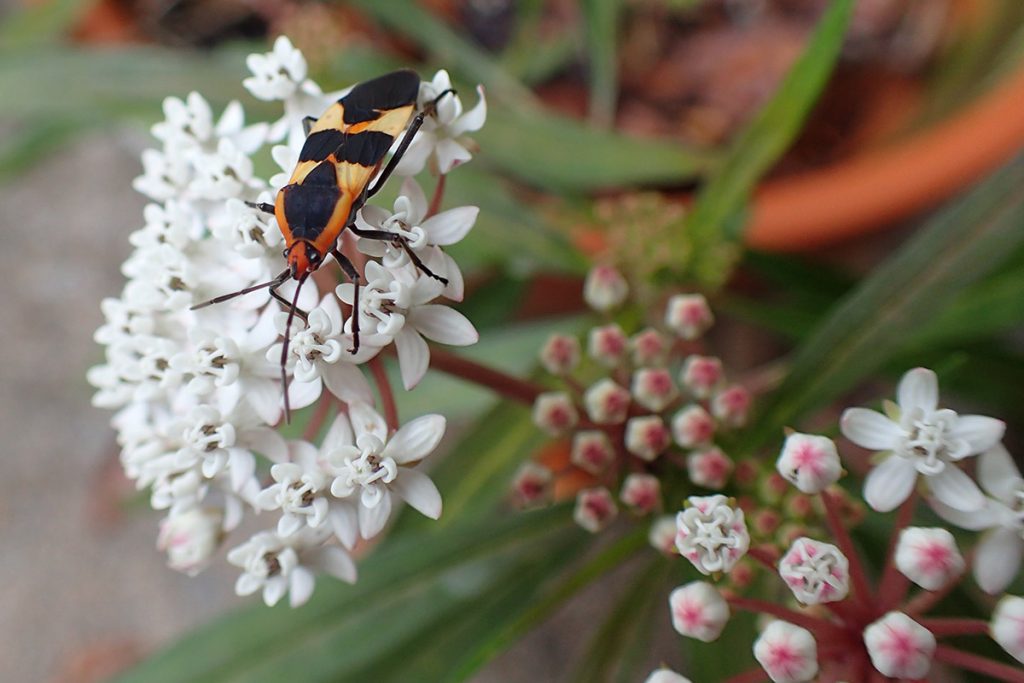
Different articles about milkweed bugs have different bits of information regarding them and monarch caterpillars. They are not specifically monarch predators; instead, they eat leaves and especially milkweed seed pods. Reading a little more, I found that they will indiscriminately eat monarch eggs and small caterpillars along with the leaves. We get rid of these guys.
The final monarch caterpillar predator I’ll mention is the most surprising- the monarch caterpillar.
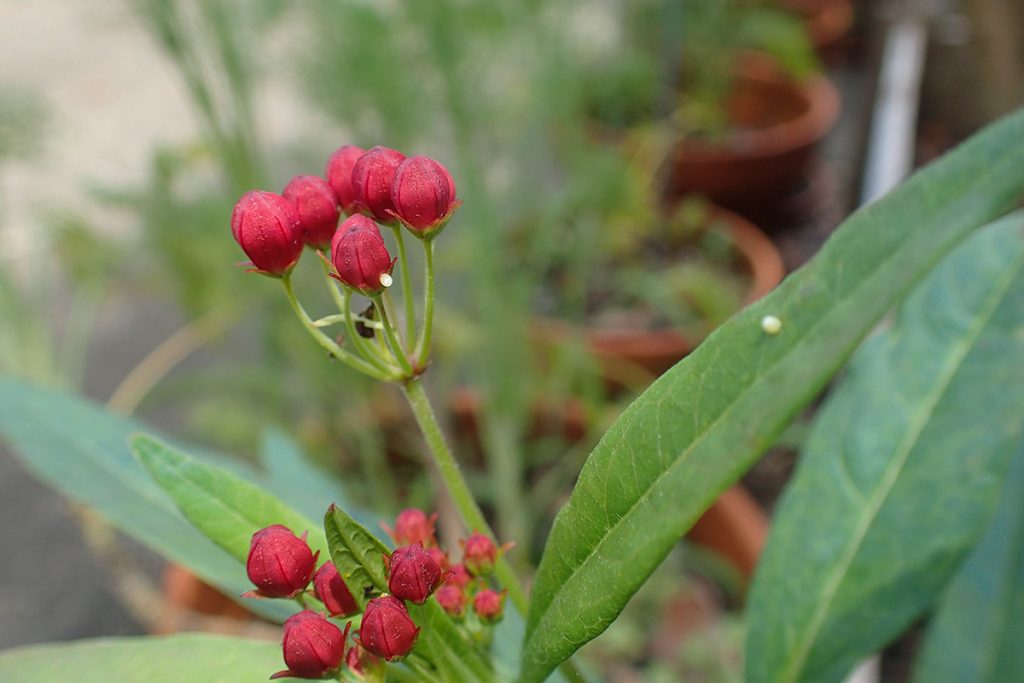
Large caterpillars will cannibalize smaller ones. And, they too will eat an egg on the leaf they’re grazing. If I have enough plants to relocate them, I try to keep caterpillars of different sizes on different plants. Even if they aren’t cannibalized, I do see that smaller caterpillars have trouble competing with larger ones for a space to graze.
Read More: Feeding caterpillars in your north Florida Garden
- Raising monarch, black swallowtail, giant swallowtail, and longtailed skipper butterflies, with photos of every life stage.
- Raising gulf fritillary caterpillars (passion flower caterpillars), with photos of every life stage.
- Caterpillar supermarkets: a list of the wildflowers and trees/ shrubs that host the most moth and butterfly caterpillar species.
- A lot of insects are out to kill your monarch caterpillars. It’s a sign that your garden is healthy.
The Best Way to Protect Monarchs: Close Them Off From the Rest of the World*
EDIT September 2021- an Alternate Conclusion
Technically, the heading above is true. However, research published in 2020 suggests that wild monarchs are bigger, stronger, and have more elongated wings than captive-raised monarchs. In other words, they have traits that make them better suited to survive.
You’ll notice an earlier edit also made in September 2021, that cites a different study suggesting monarchs better survive on plants with other non-predatory insects on them.
It’s starting to look like the best thing you can do for monarchs in your yard is to build a habitat for them, and then let them be.
August 2, 2018 update
Nearly a year after I first wrote this post, I photographed this scene:
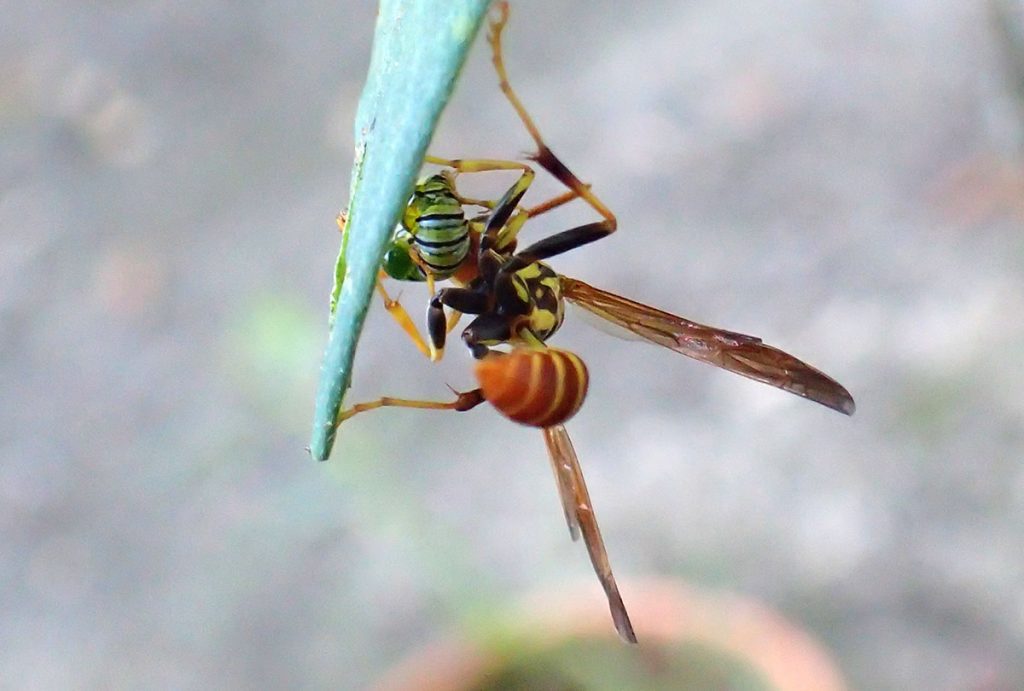
I was photographing the wasp for the Backyard Bug Blog, and only as the image stayed on the viewfinder for those two seconds after I snapped it did I realize what I was seeing. It happened fast, and it occurred to me that I couldn’t stand there all day swatting wasps away.
The best defense against fast, winged attackers, stealthy spiders, or really anything else that might pass through your yard for a minute- is to remove monarch caterpillars from the ecosystem. We want to help monarchs because they’re in decline, but the backyard ecosystem doesn’t care about that. And, the truth is, I need that wasp patrolling my tomato and pepper plants in the same way it raided my milkweed.
So clean off a plant- remove or relocate any insect other than the caterpillars. Place it in an enclosure, and enjoy watching your monarchs grow and change.
Quick plug for the Bug Blog: I’ve been photographing the bugs in my yard all year long, and through this I’ve been able to capture a few species of butterflies go through their life cycle. It’s been a great way to learn about my backyard ecosystem. It gets updated every Monday.
If I Was a Scientist…
Leaving more of the caterpillars outside this year has been educational. Observing them awakens a scientific interest within me, and I kind of wish I had more time to observe them and make notes.
For instance, as in the photo above, I see that some caterpillars lay eggs over top of the leaves (or even on flowers), instead of underneath where they are less visible. I would think that the more visible eggs were more vulnerable to predation. But how would I test that?
I’ve also noticed that caterpillars I bring inside seem to grow faster than their counterparts on the outside. Sometimes, a plant has a few caterpillars of similar size, and so I lighten its load by bringing one or two in. Do the inside caterpillars grow faster because they aren’t hindered by a fear of predators?
I remember following Dr. David Kimbro and Dr. Randall Hughes’s oyster reef research. Their caged oyster spat tiles excluded predators; the exposed tiles allowed predators access. In some experiments, a set of cages were exposed to predator cues, and some weren’t. When predators are near, oysters stop eating to make themselves less conspicuous, even when safely in a cage. This can slow their growth.
If I left an enclosure outside, would caterpillars still sense their predators? Would they grow more slowly than the caterpillars inside, where predators are completely absent?
And, like Randall and David, I would need a control cage with an opening to allow predators access, to determine if being in the cage is what was affecting results. With unlimited time, space, and resources, I could go crazy placing monarchs in different enclosures and settings, and observing all sorts of different behaviors. Maybe when Max and Xavi are older, I can push that as a science project idea.
Of course, for the results to be meaningful, we’d have to repeat them multiple times over the course of years…
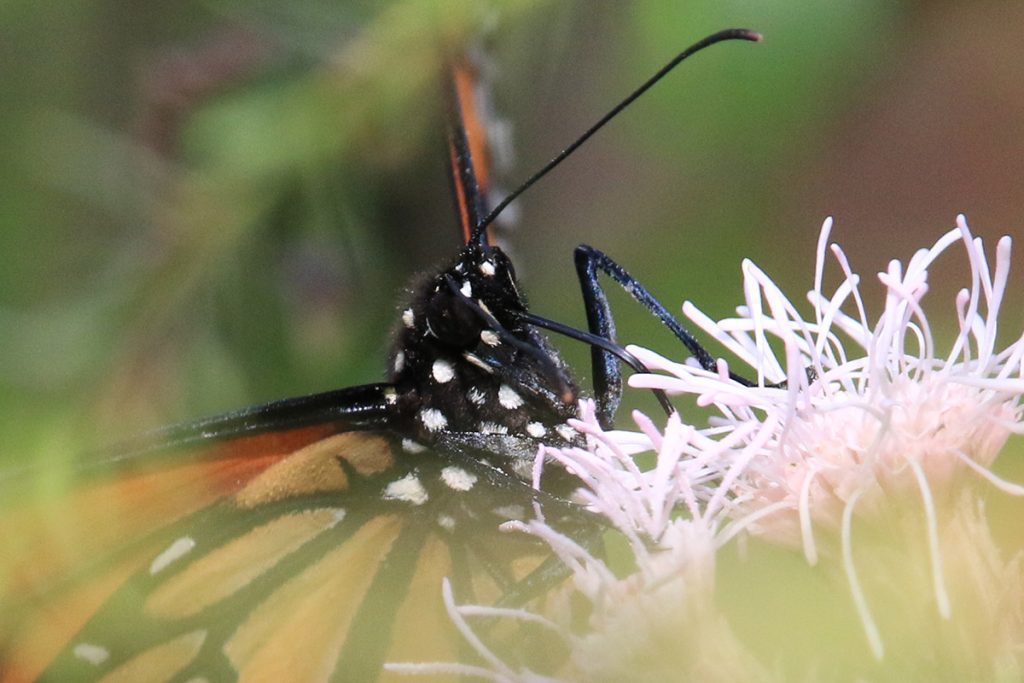
Dig Deeper into Backyard Ecology
What can we do to invite butterflies, birds, and other wildlife into our yards? And what about the flora and fauna that makes its way into our yards; the weeds, insects, and other critters that create the home ecosystem? WFSU Ecology Blog takes a closer look.
